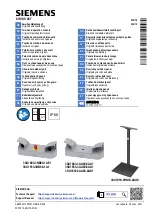
Caution
Caution
Caution
Amaprop
R
9
4
Mounting the Lifting Clamp to the
Unit
571
732
901.03
476
901.04
550.02
920
OW 385775-00
Generally, the lifting clamp (571) comes ready mounted to the
unit (in centre--of--gravity position). Mounting is achieved by
means of two hex. head bolts M12x30 (901.03) to the guide
claw (732), and by means of a hex. head bolt M12x55 (901.04),
two nuts M12 (920) and a disc A13 (550.02) to the seat ring
holder (476).
Tightening torque M12: 60Nm.
5
Hitching the Lifting Tackle to the
Unit
5.1
Attachment Point
The attachment point at the lifting clamp serves to lower the
unit, together with its lifting clamp, along the guide rail (square
rail with cross--sectional dimensions 100x100x3 or 100x100x5)
and into the tank.
~5
o
When retaining the unit at the lifting clamp ensure that an
inclination of ~5
°
(high end = propeller end) is maintained for
easy raising and lowering of the mixer. If this angle cannot be
achieved, rectify the attachment point to avoid problems in
lowering and raising.
Please refer to the tables in the Annex.
The type size is given on the nameplate on the motor housing
cover. Please check whether the correct hole has been
selected on the lifting clamp (counting from the propeller end).
Procedure
Please note drawing in section 4.
Slightly loosen the bolts 901.03 on the guide claw 732 and
901.04 on the seat ring holder 476 as well as the upper bolted
connection of the lifting clamp. Choose the correct hole in the
lifting clamp from the tables given in the Annex, depending on
the inclination of the mixer. Try attaching the unit again. If now
an angle of ~5
o
is reached, the gravity centre position is found.
Re--tighten all bolts M12 to a tightening torque
of 60Nm! If this is not done, the lifting clamp
may come off during operation and damage the unit or the
installation components! In this case, the mixer cannot be
removed from the tank either.
5.2
Lifting Hook
If a lifting hook is provided for raising and lowering the unit, it
must be attached to the hoisting rope of the lifting gear (crane)
by means of a shackle.
Check that the bolt of the shackle has been
properly tightened! If not, the lifting hook may
come off the crane during the raising/ lowering of the unit. This
would lead to damage/destruction of the unit and/or its
installation accessories!
250
Æ
30
The lifting hook may only be used for the submersible mixers
specified in this operating manual. (Safe working load max. 500
kg)!
5.3
Hoisting Rope
If a lifting gear (crane) is used for raising and lowering which is
suitable for both stationary and portable installation (socket/
holder for crane to be provided), the hoisting rope
(corrosion--resistant steel) can be directly attached to the lifting
clamp at the attachment point by means of a shackle.
To avoid damage to the lifting rope and/or the shackle during
mixer operation, the hoisting rope should always remain slightly
tightened -- on stationary cranes this is achieved by positioning
the crane winch accordingly. On transportable cranes, which
require the rope to be removed from the winch, the rope
tensioner/bollard --included in KSB’s scope of supply -- should
ensure that the rope is slightly tightened (observe section 9.1).
Ropes with too much slack may damage the
attachment point at the lifting clamp due to the
constant flow--induced motion (fraying!) or even get into the
rotating propeller blades (with consequential damage to the
unit/installation parts and the lifting gear).
In applications with extreme fibre and/or solids content (e.g.
sand), a lifting hook should be preferred.
Summary of Contents for Amaprop 1200
Page 38: ...AmapropR...
Page 39: ...AmapropR...










































